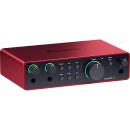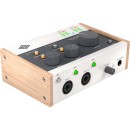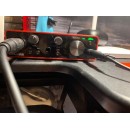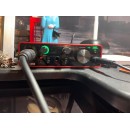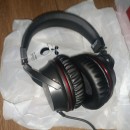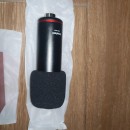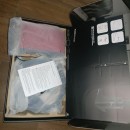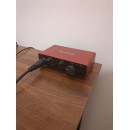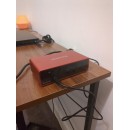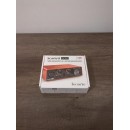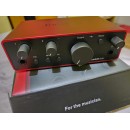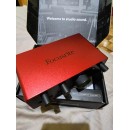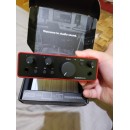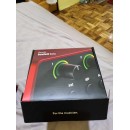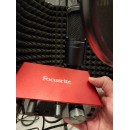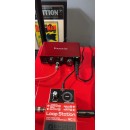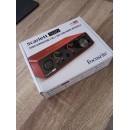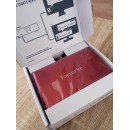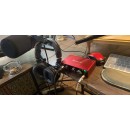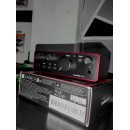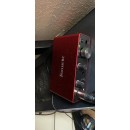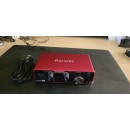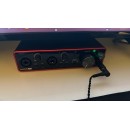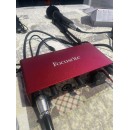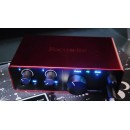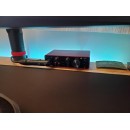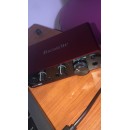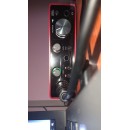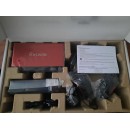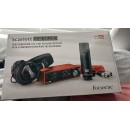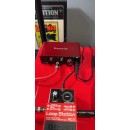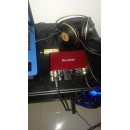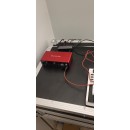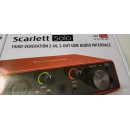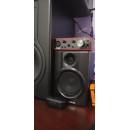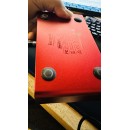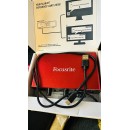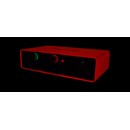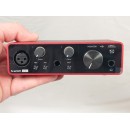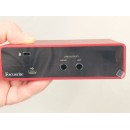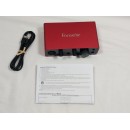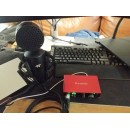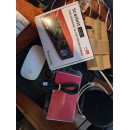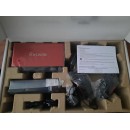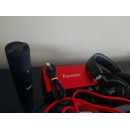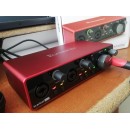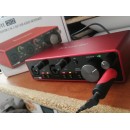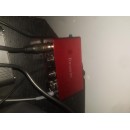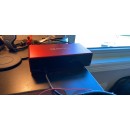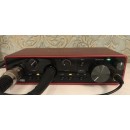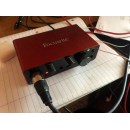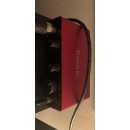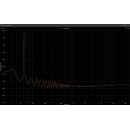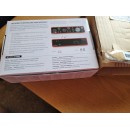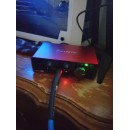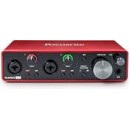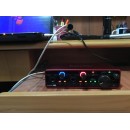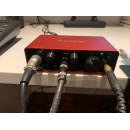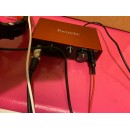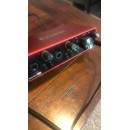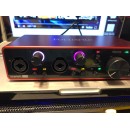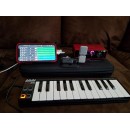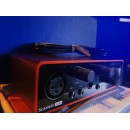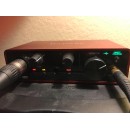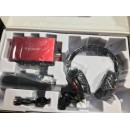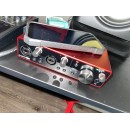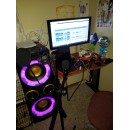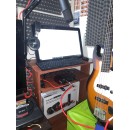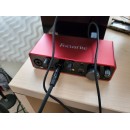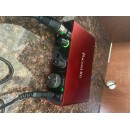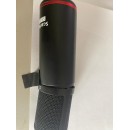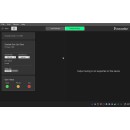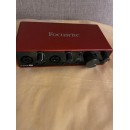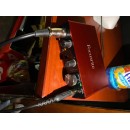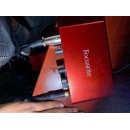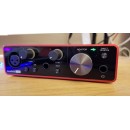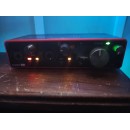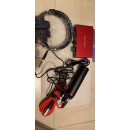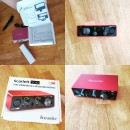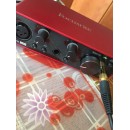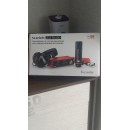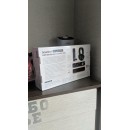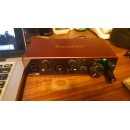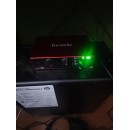Universal Audio Volt 276 vs Focusrite Scarlett 2i2: Detailed Comparison
The Focusrite Scarlett 2i2 (4th Gen) continues the brand’s legacy of providing reliable, high-performance audio interfaces. It features two upgraded Scarlett mic preamps with switchable Air mode, which adds brightness and presence to vocals and acoustic instruments. The 24-bit/192kHz converters ensure pristine sound quality, and the interface includes two high-headroom instrument inputs, allowing users to directly connect guitars or basses. USB-C connectivity ensures low-latency performance and compatibility with modern computing devices. The Scarlett 2i2 is also bundled with a comprehensive software package, including Ableton Live Lite and the Focusrite Plug-in Collective, making it an excellent choice for beginners and professionals alike.
The Universal Audio Volt 276, on the other hand, distinguishes itself with its built-in analog compressor, inspired by the Universal Audio 1176, providing classic, warm compression to your recordings. This 2x2 USB Type-C audio/MIDI interface also boasts high-quality 24-bit/192kHz audio conversion and two vintage mic preamps that emulate the sound of Universal Audio’s classic 610 tube preamp, adding rich harmonics and character to your recordings. The Volt 276 is equipped with MIDI I/O, making it a versatile choice for those who work with MIDI controllers and instruments. The included software bundle, featuring titles from Ableton, Melodyne, and UJAM, further enhances the creative potential of this interface.
In summary, the Focusrite Scarlett 2i2 (4th Gen) excels in providing a straightforward, high-quality recording experience with its upgraded preamps and extensive software bundle. The Universal Audio Volt 276, with its built-in analog compressor and vintage preamp emulation, offers added tonal flexibility and creative possibilities, making it particularly appealing to those seeking a more colored, analog sound. Both interfaces ensure high-fidelity recordings and modern connectivity, catering to different user preferences and recording styles.
Specifications, Advantages, and Disadvantages
| User Rating Based on Analysis of Reviews | |
|---|---|
|
Show More |
| Pros: | |
|---|---|
|
|
| Cons: | |
|---|---|
|
|
| Key Specs | |
|---|---|
| Channels of I/O | |
| Analog: 2 Inputs / 2 Outputs at 192 kHz |
Analog: 2 Inputs / 2 Outputs |
| Maximum Sampling Rate | |
| 192 kHz / 24-Bit | 192 kHz / 24-Bit |
| Number of Microphone Inputs | |
| 2 | 2 Preamps |
| Analog Audio I/O | |
| 2x XLR 3-Pin Balanced Mic Input 2x 1/4" TRS Balanced/Unbalanced Line/Hi-Z Input (Front Panel) 2x 1/4" TRS Balanced Monitor Output 1x 1/4" TRS Headphone Output (Front Panel) |
2x Combo XLR-1/4" TRS Balanced/Unbalanced Mic/Line/Hi-Z Input (Front Panel) 2x 1/4" TRS Balanced Monitor Output 1x 1/4" TRS Unbalanced Headphone Output (Front Panel) |
| Host Connection | |
| 1x USB-C | 1x USB-C |
| OS Compatibility | |
| macOS Windows |
macOS 10.14 or Later Windows 10 (64-Bit Only) 14 or Later iPadOS 14 or Later |
| Power Requirements | |
| USB Bus Power, USB Power Adapter (Not Included) | AC/DC Power Adapter (Not Included) or USB Bus Power |
In terms of I/O channels, both interfaces provide analog 2 inputs and 2 outputs at 192 kHz. This ensures high-fidelity audio recording and playback, making both options suitable for professional and home studio environments. Both units also support a maximum sampling rate of 192 kHz / 24-Bit, offering pristine audio quality during recording and playback.
For microphone inputs, both the Focusrite Scarlett 2i2 and the Universal Audio Volt 276 provide 2 inputs. However, the Universal Audio Volt 276 specifies that these are preamps, which may imply specific preamp characteristics or additional functionality that might appeal to certain users.
When it comes to analog audio I/O, the Focusrite Scarlett 2i2 features 2x XLR 3-Pin Balanced Mic Inputs, 2x 1/4" TRS Balanced/Unbalanced Line/Hi-Z Inputs on the front panel, 2x 1/4" TRS Balanced Monitor Outputs, and 1x 1/4" TRS Headphone Output on the front panel. In contrast, the Universal Audio Volt 276 offers 2x Combo XLR-1/4" TRS Balanced/Unbalanced Mic/Line/Hi-Z Inputs on the front panel, 2x 1/4" TRS Balanced Monitor Outputs, and 1x 1/4" TRS Unbalanced Headphone Output on the front panel. The combo inputs on the Volt 276 provide versatility but the headphone output is unbalanced compared to the balanced output on the Scarlett 2i2.
In terms of digital audio I/O, the Focusrite Scarlett 2i2 does not offer any, whereas the Universal Audio Volt 276 also does not provide digital audio I/O but includes MIDI functionality, which can be a significant advantage for users needing MIDI connectivity.
Both interfaces connect to the host via a USB-C connection and are compatible with macOS and Windows operating systems. The Universal Audio Volt 276 has additional compatibility with iPadOS 14 or later, which could be beneficial for mobile recording setups.
Regarding power requirements, the Focusrite Scarlett 2i2 is powered via USB Bus Power or a USB Power Adapter (not included). On the other hand, the Universal Audio Volt 276 can be powered either by an AC/DC Power Adapter (not included) or USB Bus Power, offering a bit more flexibility in power options.
In summary, both the Focusrite Scarlett 2i2 and Universal Audio Volt 276 provide robust features for high-quality audio recording, with the Scarlett 2i2 offering balanced headphone outputs and the Volt 276 providing combo inputs and additional iPadOS compatibility. The choice between the two may ultimately come down to specific needs such as MIDI connectivity and power flexibility.
| General | |
|---|---|
| Channels of I/O | |
| Analog: 2 Inputs / 2 Outputs at 192 kHz |
Analog: 2 Inputs / 2 Outputs |
| Maximum Sampling Rate | |
| 192 kHz / 24-Bit | 192 kHz / 24-Bit |
| Number of Microphone Inputs | |
| 2 | 2 Preamps |
| Input Level Adjustment | |
| 2x Knob | 2x Knob |
| Expansion Slots | |
Both interfaces offer 2 analog inputs and 2 analog outputs, and they support a maximum sampling rate of 192 kHz at 24-bit resolution, ensuring high-quality audio recording and playback. Each device is equipped with 2 microphone inputs, making them suitable for recording vocals or instruments with high fidelity.
The Focusrite Scarlett 2i2 does not include built-in DSP (Digital Signal Processing), whereas the Universal Audio Volt 276 features a built-in compressor. This compressor can be a significant advantage for users who want more control over their audio dynamics during recording, potentially reducing the need for additional outboard gear or post-processing.
Neither interface includes built-in microphones, which is standard for audio interfaces in this category. Both devices allow for input level adjustment via two knobs, providing straightforward control over input gain.
In terms of expansion capabilities, both the Focusrite Scarlett 2i2 and the Universal Audio Volt 276 do not offer expansion slots, keeping them compact and focused on their core functions without the need for additional modularity.
Overall, while both interfaces offer similar core features and high-quality audio performance, the Universal Audio Volt 276 stands out with its built-in compressor, potentially offering more versatility directly from the interface.
| Signal Processing |
|---|
| Connectivity | |
|---|---|
| Analog Audio I/O | |
| 2x XLR 3-Pin Balanced Mic Input 2x 1/4" TRS Balanced/Unbalanced Line/Hi-Z Input (Front Panel) 2x 1/4" TRS Balanced Monitor Output 1x 1/4" TRS Headphone Output (Front Panel) |
2x Combo XLR-1/4" TRS Balanced/Unbalanced Mic/Line/Hi-Z Input (Front Panel) 2x 1/4" TRS Balanced Monitor Output 1x 1/4" TRS Unbalanced Headphone Output (Front Panel) |
| Phantom Power | |
| 48 V, Selectable On/Off | 48 V, Selectable On/Off (Applied to All Inputs) |
| Digital Audio I/O | |
| Host Connection | |
| 1x USB-C | 1x USB-C |
| Host Connection Protocol | |
| USB 2.0 | USB 2.0 |
| USB (Non-Host) | |
| 1x USB-C (Power Input) | |
| Sync I/O | |
| Network I/O | |
| MIDI I/O | |
|
1x DIN 5-Pin Input 1x DIN 5-Pin Output |
|
Focusrite Scarlett 2i2 USB-C Audio Interface (4th Generation): - Analog Audio I/O: It provides 2x XLR 3-Pin Balanced Mic Inputs and 2x 1/4" TRS Balanced/Unbalanced Line/Hi-Z Inputs on the front panel. It also includes 2x 1/4" TRS Balanced Monitor Outputs and 1x 1/4" TRS Headphone Output on the front panel. - Phantom Power: The interface offers 48 V phantom power that is selectable on/off. - Digital Audio I/O: There are no digital audio I/O options available. - Host Connection: It connects via 1x USB-C using USB 2.0 protocol. - USB (Non-Host): It has 1x USB-C port for power input. - Sync I/O: No sync I/O is available. - Network I/O: There is no network I/O. - MIDI I/O: This model does not include MIDI I/O capabilities. - Wireless: There are no wireless features.
Universal Audio Volt 276 Portable 2x2 USB Type-C Audio/MIDI Interface with Built-In Compressor: - Analog Audio I/O: It features 2x Combo XLR-1/4" TRS Balanced/Unbalanced Mic/Line/Hi-Z Inputs on the front panel. Additionally, it has 2x 1/4" TRS Balanced Monitor Outputs and 1x 1/4" TRS Unbalanced Headphone Output on the front panel. - Phantom Power: This interface also offers 48 V phantom power, which is selectable on/off and applied to all inputs. - Digital Audio I/O: There are no digital audio I/O options available. - Host Connection: It connects via 1x USB-C using USB 2.0 protocol. - USB (Non-Host): There is no additional USB (non-host) port. - Sync I/O: No sync I/O is available. - Network I/O: There is no network I/O. - MIDI I/O: The Volt 276 includes 1x DIN 5-Pin MIDI Input and 1x DIN 5-Pin MIDI Output, providing greater flexibility for MIDI devices. - Wireless: There are no wireless features.
In summary, while both the Focusrite Scarlett 2i2 (4th Generation) and the Universal Audio Volt 276 are robust audio interfaces with similar analog audio I/O and host connection capabilities, they differ in their additional features. The Scarlett 2i2 lacks MIDI I/O, whereas the Volt 276 includes it, making the Volt 276 a more versatile option for those who need MIDI connectivity. The built-in compressor in the Volt 276 is another distinguishing feature that might appeal to users looking for more advanced signal processing capabilities.
| Digital Audio | |
|---|---|
| Sample Rates | |
| 44.1 / 48 / 88.2 / 96 / 176.4 / 192 kHz | Up to 192 kHz |
| Bit Depths | |
| 24-Bit | 24-Bit |
| Sync Sources | |
| Internal | Internal |
Starting with sample rates, the Focusrite Scarlett 2i2 offers a range of options, including 44.1, 48, 88.2, 96, 176.4, and 192 kHz. This broad selection provides flexibility for various recording scenarios, from standard CD quality to high-definition audio. In comparison, the Universal Audio Volt 276 supports sample rates up to 192 kHz, which also ensures high-fidelity recordings but doesn't specify intermediate rates like the Scarlett 2i2.
Both interfaces offer a bit depth of 24-Bit, ensuring professional-grade audio resolution. This bit depth is standard among high-quality audio interfaces and provides a good dynamic range and low noise floor.
Regarding sync sources, both the Focusrite Scarlett 2i2 and the Universal Audio Volt 276 utilize internal sync. This feature ensures that the audio interface maintains its timing accuracy independently, which is crucial for stable and reliable audio performance.
The Universal Audio Volt 276 has a notable feature in its zero-latency direct monitoring capability, which is particularly advantageous for live recording and monitoring, ensuring that the performer hears the audio in real-time without any delay. The Focusrite Scarlett 2i2 does not explicitly mention zero-latency monitoring in the provided specifications.
In summary, while both audio interfaces offer high-resolution 24-bit audio and internal sync sources, the Focusrite Scarlett 2i2 provides a wider range of sample rates, and the Universal Audio Volt 276 stands out with its zero-latency direct monitoring feature, which can be a significant advantage for real-time audio applications.
| Audio Storage & Playback |
|---|
| Compatibility | |
|---|---|
| OS Compatibility | |
| macOS Windows |
macOS 10.14 or Later Windows 10 (64-Bit Only) 14 or Later iPadOS 14 or Later |
In terms of OS compatibility, the Focusrite Scarlett 2i2 supports macOS and Windows operating systems. It also offers mobile app compatibility exclusively with iPadOS. On the other hand, the Universal Audio Volt 276 extends its OS compatibility to macOS 10.14 or later and Windows 10 (64-bit only). Additionally, it supports iPadOS 14 or later, which includes compatibility with a broader range of mobile devices such as iPad Pro, iPad, and iPhone.
The processor requirements for the Universal Audio Volt 276 are more specific, requiring either an Intel or Apple M1 processor for Mac and an Intel or AMD processor for PC. This suggests a need for relatively recent hardware to ensure optimal performance. Additionally, the Volt 276 necessitates an available USB 2.0 port and includes a USB cable for connectivity, along with an internet connection required for registration and software/driver download.
In contrast, the Focusrite Scarlett 2i2's specifications do not detail specific processor requirements nor does it mention the necessity of an internet connection for registration or software downloads. This could imply a potentially broader compatibility with various system configurations and a more straightforward setup process.
Overall, while both interfaces offer high-quality audio recording capabilities, the Universal Audio Volt 276 provides additional features such as built-in compression and broader device compatibility, which may appeal to users requiring versatile and detailed hardware specifications. The Focusrite Scarlett 2i2, however, offers simpler integration with macOS, Windows, and iPadOS, making it an attractive option for users seeking ease of use and straightforward setup.
| Power | |
|---|---|
| Power Requirements | |
| USB Bus Power, USB Power Adapter (Not Included) | AC/DC Power Adapter (Not Included) or USB Bus Power |
| AC/DC Power Adapter | |
| 5 VDC at 900 mA | 5 VDC (Not Included) |
The Focusrite Scarlett 2i2 (4th Generation) can be powered through USB Bus Power or via a USB Power Adapter, though the adapter is not included. It requires an AC/DC Power Adapter with specifications of 5 VDC at 900 mA and consumes 4.5 watts of power. This flexibility in power options makes it convenient for various recording environments, whether in the studio or on the go.
In comparison, the Universal Audio Volt 276 also provides dual power options: it can be powered through an AC/DC Power Adapter (which is not included) or via USB Bus Power. The required AC/DC Power Adapter for the Volt 276 is specified at 5 VDC. However, detailed power consumption information is not provided for the Volt 276, making it less transparent in terms of energy efficiency compared to the Scarlett 2i2.
In summary, both interfaces offer the convenience of USB Bus Power and the option for an AC/DC Power Adapter. The Scarlett 2i2 specifies its power consumption clearly at 4.5 watts and requires a 5 VDC adapter at 900 mA, whereas the Volt 276 specifies only the need for a 5 VDC adapter without further details on power consumption.
| Physical |
|---|
| Packaging Info | |
|---|---|
| Package Weight | |
| 1.9 lb | 2.615 lb |
| Box Dimensions (LxWxH) | |
| 8.2 x 7 x 2.6" | 9.7 x 7.7 x 4.4" |
Focusrite Scarlett 2i2 USB-C Audio Interface (4th Generation): - Package Weight: 1.9 lb - Box Dimensions (LxWxH): 8.2 x 7 x 2.6"
Universal Audio Volt 276 Portable 2x2 USB Type-C Audio/MIDI Interface with Built-In Compressor: - Package Weight: 2.615 lb - Box Dimensions (LxWxH): 9.7 x 7.7 x 4.4"
In terms of package weight, the Focusrite Scarlett 2i2 is lighter at 1.9 lb compared to the Universal Audio Volt 276 which weighs 2.615 lb. This difference in weight might make the Scarlett 2i2 a more convenient option for users who prioritize portability and ease of transportation.
Regarding the box dimensions, the Focusrite Scarlett 2i2 is more compact with dimensions of 8.2 x 7 x 2.6", whereas the Universal Audio Volt 276 is larger, measuring 9.7 x 7.7 x 4.4". The Scarlett 2i2's smaller size could be an advantage for those with limited desk space or for users who need to frequently move their audio interface between different locations.
Both interfaces offer USB Type-C connectivity, which ensures fast data transfer and compatibility with modern devices. The Universal Audio Volt 276 distinguishes itself by featuring a built-in compressor, which can be a valuable tool for users looking to add professional-quality dynamics processing to their recordings without needing additional external hardware.
Overall, the choice between these two audio interfaces will depend on the user's specific needs regarding portability, desk space, and built-in features like the compressor.
| Customer Images | |
|---|---|
| Videos | |
|---|---|
|
|
|
